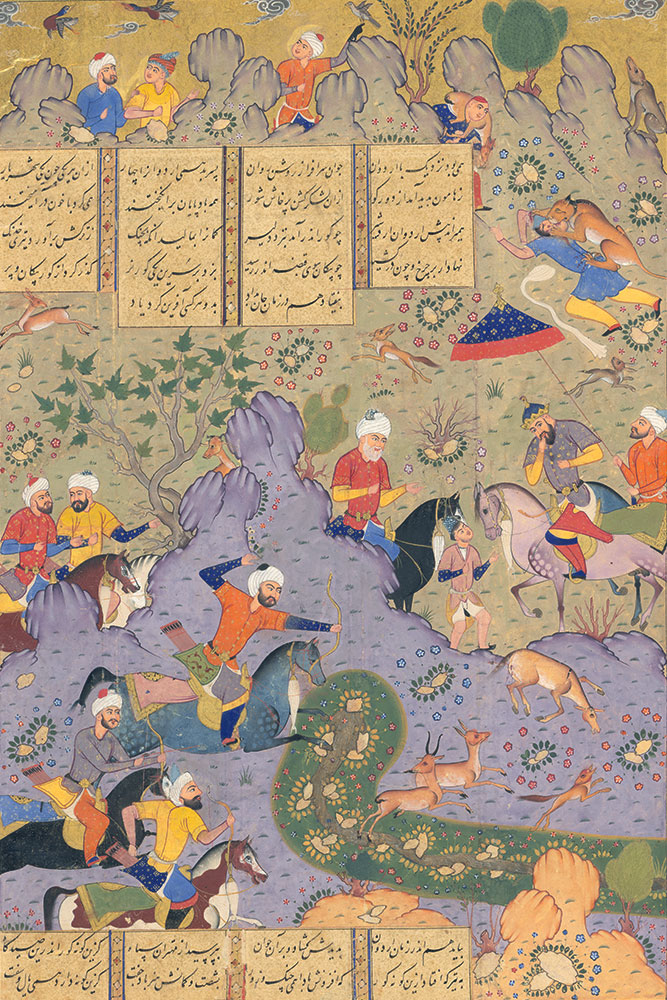
The Shahnameh is an epic poem of over 50,000 couplets written in Early New Persian. It is based mainly on a prose work of the same name compiled in Ferdowsi's earlier life in his native Tus. The Shahnameh was in turn and for the most part the translation of a Pahlavi (Middle Persian) work, known as the Xwadāynāmag "Book of Kings", a late Sasanian compilation of the history of the kings and heroes of Persia from mythical times down to the reign of Khosrau II (590–628). Ferdowsi added material continuing the story to the overthrow of the Sasanians by the Muslim armies in the middle of the seventh century.
‘Siyavush and Afrasiyab in the Hunting Field’, from the long epic Persian poem, Shahnameh (or Book of Kings), tells the epic legend of Siyâvash, a legendary Persian prince from the earliest days of the Persian Empire. The artist portrays Siyavush as a handsome and desirable young man, his name literally meaning "the one with the black horse" or "black stallion". Ferdowsi, the author of the Shahnameh, names his horse Shabrang Behzād, literally "night-coloured purebred." Here, he is seen riding on a hunt alongside Afrasiyab, the tyrannical ruler of Turan, a mythical land north of Iran.
In a richly layered tableau, several huntsmen can be seen charging after deer but the two central characters, Siyavush and Afrasiyab, stand out by nature of the dynamic stance of their horses as they face each other in the centre of the illustration and the two leaders engage in peaceful conversation and rapprochement. They are attended to by footmen, one controlling the standing quadrupeds and the other providing Afrasiyab with the shade of a parasol. Around them we observe advisors as well as other hunters, who can be seen dynamically pursuing prey as evidenced through their engagement with the instruments of the hunt, bow and arrows, in the lower half of the painting.
With a rich chromatic palette, the natural environment is seen thriving with fauna and flora despite man’s presence: in verdant fields, craggy mountains and swirling streams, nature has imposed order and both animals and plants regenerate at each turn. In one tragic moment of contrast to the hunt, a man can be seen falling prey to a feline predator in the upper register of the illustration.
Costumes are rendered with intense colours while vegetation and animals are given a more subtle palette. The headgear of all the figures, Iranians and Turanians alike, consists of turbans folded around caps with tall red projections, taj-i Haydari. These distinctive turbans were worn by the followers of Tahmasp and suggest a sense of identification with the Shahnama at the Safavid court.
As background to the depicted event, the Iranian king Kay Kavus decided to wage war against Turan (Turkestan), even though his son, prince Siyavush, had signed a treaty with the Turanian king, Afrasiyab. Siyavush chose to disregard his father’s orders and accept Afrasiyab’s invitation to visit Turan and take refuge in the realm, thereby averting yet another war between Iran and Turan. Afrasiyab, ruler of Turan, had declared war on the Iranians again. Kay Kavus decided to make an example of Afrasiyab's allies in the City of Balkh, and planned to invade it, but is dissuaded from personally attending the battlefield by Rostam, the ultimate hero of the Shahnameh. Siyavush volunteers for duty, and is immediately sent towards Balkh, and certain war. This illustration portrays a moment of optimism and brotherhood between the Turanians and the Iranians.
As we now better understand, Shiraz artists were working in Northern India and in the Deccan in the mid - late 16th century. It is possible that some of the faces may have later repainting.
Provenance:
Private collection, UK, 1960s
Price On Request
|

